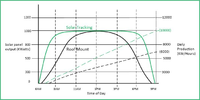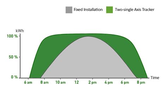I saw this amazingly simple solar tracker circuit on LinkedIn, and thought some of you might be interested in it. There's a video following the schematic. A single D2822M audio amp chip, a couple LDRs (Light Dependent Resistor) and a couple resistor are all that's required to drive a geared DC motor to aim a sensor at the sun....and presumably some sort of solar array. The D2822 is an audio amp designed for cassette recorders, but it can be considered as two power op-amps, capable of 700mA output. LCSC.com has D2822Ns in stock.
I'm drawn the schematic here. One change I would make is to replace one of the 10k resistors with a 5k resistor and a 10k pot to adjust out any difference in the LDRs.

I'm drawn the schematic here. One change I would make is to replace one of the 10k resistors with a 5k resistor and a 10k pot to adjust out any difference in the LDRs.



